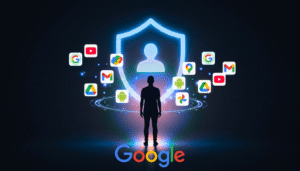
Cybercrime isn’t just something that happens to “other people” anymore. It’s hitting all of us whether you’re casually scrolling through Instagram, working professional, or a business owner. The truth is? These digital criminals are stepping up their game. 2024 and 2025 have brought some scary new threats, like deep fakes and ransomware which are targeting businesses and individuals. So, let’s get real about how this affects you and how you can stay safe.
Who Cybercriminals Are Targeting: Spoiler—It’s Not Just Big Companies
1. You Could Be the Next Target—Here’s Why
Have you ever received a sketchy call claiming to be from the police, a family member, or even your bank asking you to install an app? These “digital arrest” scams became a huge problem in 2024, tricking people into handing over remote access to their phones. Once that happens, scammers can drain your bank accounts or lock up your phone for ransom.
| Statistic | Value | Real-Life Example |
| Cybercrime Cases in India (2024) | 1.5 million | A bank employee in Rourkela lost ₹3.58 lakh after responding to a fake call posing as a bank representative. |
| Percentage of Financial Fraud (2024) | 45% | A family in Ahmedabad lost ₹12,000 to a scam involving a fake KYC update. |
2. Your Business is not Safe: Here’s Why
From hospitals to small businesses, no one is immune to knowledge. Hackers love to target industries like finance, healthcare, and even crypto exchanges.
Remember the WazirX hack? Hackers made off with ₹235 million. And, a data breach at Angel One exposed 7.9 million customers’ personal details.
| Statistic | Value | Real-Life Example |
| Businesses Affected by Cybercrime (2024) | 60% | A trader in Ahmedabad lost ₹28 lakh to a scam where a Fake Angel One assistant convinced him to invest in a fraudulent app. |
| Ransomware Incidents | 45% of business cyberattacks | A major hospital chain in Bengaluru faced a ransomware attack, crippling its operations for over a week. |
3. Government Systems Under Siege: The Growing Threat to National Security
Even our government isn’t safe from these digital troublemakers. Government websites and essential stuff like power grids are getting hammered with attacks non-stop. Just look at what’s happening in Maharashtra—hackers keep going after their official portals, creating absolute chaos for everyone trying to use those services.
| Statistic | Value | Real-Life Example |
| Government Cyber Attacks (2024) | 14,000+ | Telangana Police arrested 20 cybercriminals from Surat wanted in 515 cases across India. |
| Increase in Cybercrime Against Critical Infrastructure | 47% increase (2023-2024) | Maharashtra Cyber Police reported 10+ high-profile attacks on government portals, disrupting operations. |
How Cybercriminals Are Evolving: You Won’t Believe Their New Tactics

1. AI and Deepfakes—Scammers Are Getting Way Too Good at This
Imagine getting a call that sounds exactly like your brother or your mom asking for urgent help. Thanks to voice cloning and deep face technology, that’s happening now more than ever.
2. QR Code Scams—Watch Out When You Pay!
You scan what looks like a legit QR code to pay for your burger, but surprise—your cash just landed in some random scammer’s pocket instead of the restaurant’s. These phony QR codes are popping up everywhere these days, especially in packed spots where nobody’s paying close attention to what they’re actually scanning.
| Statistic | Value | Real-Life Example |
| Increase in QR Code Fraud (2024) | 300% increase from previous year | In New Delhi, a woman lost ₹45,000 after scanning a fake QR code at a local café. |
| Number of QR Code Fraud Cases (2024) | 5,000+ | A family in Mumbai fell victim to a scam when their payment for groceries was redirected to a scammer’s account via a fake QR code. |
3. Remote Access Scams—Don’t Let Curiosity Get You Into Trouble
These online crooks have mastered the art of making you click stuff you shouldn’t—whether it’s those bogus “update your KYC now or your account will be blocked” messages or nasty malware hiding in what looks like a friend’s wedding invitation. This isn’t just hypothetical, one engineer working at DRDO in Pune clicked the wrong link once and boom, ₹12.95 lakh gone, just like that. That’s over a million rupees vanishing with a single click.
Real-Life Cases You Need to Know About—And Why They Should Scare You
These aren’t just headlines—they’re warnings.
| Cybercrime Case | Details |
| WazirX Hack (July 2024) | Hackers linked to North Korea stole millions from WazirX. |
| Angel One Leak (2023–2024) | A massive data breach exposed sensitive customer info, shaking confidence. |
| BSNL Breach (June 2024) | Over 278 GB of telecom data was leaked, possibly enabling SIM cloning. |
| Fake Wedding Invites | Malware hidden in “wedding PDFs” sent via WhatsApp led to data theft. |
What Experts Are Saying—And Why You Should Listen
India’s Cyber Crime Coordination Centre (I4C) revealed a shocking ₹11,000 crore in fraud losses during just the first half of 2024. That’s about ₹60 crore every day.
Private cybersecurity firms also warn of rising threats. 370 million malware attacks were reported in India in 2024 alone.
| Statistic | Value | Real-Life Example |
| Cybercrime Fraud Losses (2024 – First Half) | ₹11,000 crore | A bank in Chennai was duped of ₹5 crore by hackers who tricked its employees into transferring funds. |
| Malware Attacks in India (2024) | 370 million | A company in Bangalore was infected with malware that stole millions of customer records. |
How You Can Stay Safe: Simple Steps to Protect Yourself
For Everyone:
- Use strong passwords – Come on, “password123” seriously? That’s like leaving your front door wide open with a “rob me” sign.
- Enable two-factor authentication – This takes like 30 seconds to set up and makes your accounts way harder to hack. Just do it already.
- Don’t click on strange links or attachments – If you weren’t expecting that “urgent document” or “amazing offer,” just don’t tap on it. Not worth the headache.
- Never share your OTP or banking details – Even if the person on the phone sounds like they know what they’re talking about or claims to be from your bank. Just hang up.
- Verify before you trust – When in doubt, hang up and call the company’s official number yourself. Better to be a little paranoid than completely broke.
For Individuals:
- Install antivirus software – It’s literally the bare minimum protection, like wearing a helmet on a motorcycle. Takes five minutes and could save you from a world of pain.
- Be cautious about what you share on social media – Your vacation dates, home address, and kid’s school schedule? Yeah, maybe keep some of that to yourself instead of broadcasting it to every scammer with an internet connection.
- Double-check payment details – Take those extra few seconds to verify UPI IDs before hitting “send” on your money. Once it’s gone, good luck getting it back.
For Businesses:
- Regularly audit your network and run those phishing tests on your team—you’ll be shocked who clicks what.
- Use intrusion detection systems like your digital security guard, back up your critical data before it vanishes, and don’t sleep on those security patches.
- Follow CERT-In’s guidelines because they’re seeing the attacks before you do, and pay attention to those alerts targeting your specific industry.
For Government & Infrastructure Operators:
- Use industrial-grade security tools that actually work, not the cheap stuff—and separate your networks so one breach doesn’t take down everything.
- Take part in cybersecurity drills because fumbling during a real attack is way worse than feeling awkward during practice.
- Proactively share incident data when you get hit—your painful experience might save someone else from the same nightmare.
Conclusion
Cybercrime is on the rise, and it’s affecting everyone. Whether you’re a tech professional, a business owner, or just someone using WhatsApp, you need to be aware of the risks. Cybersecurity isn’t just for IT people anymore—it’s for all of us.
Together, we can build a safer online world. Stay informed, stay vigilant, and don’t let the crooks get the best of you. Let’s make cybersecurity a priority today, so we can protect ourselves tomorrow.



